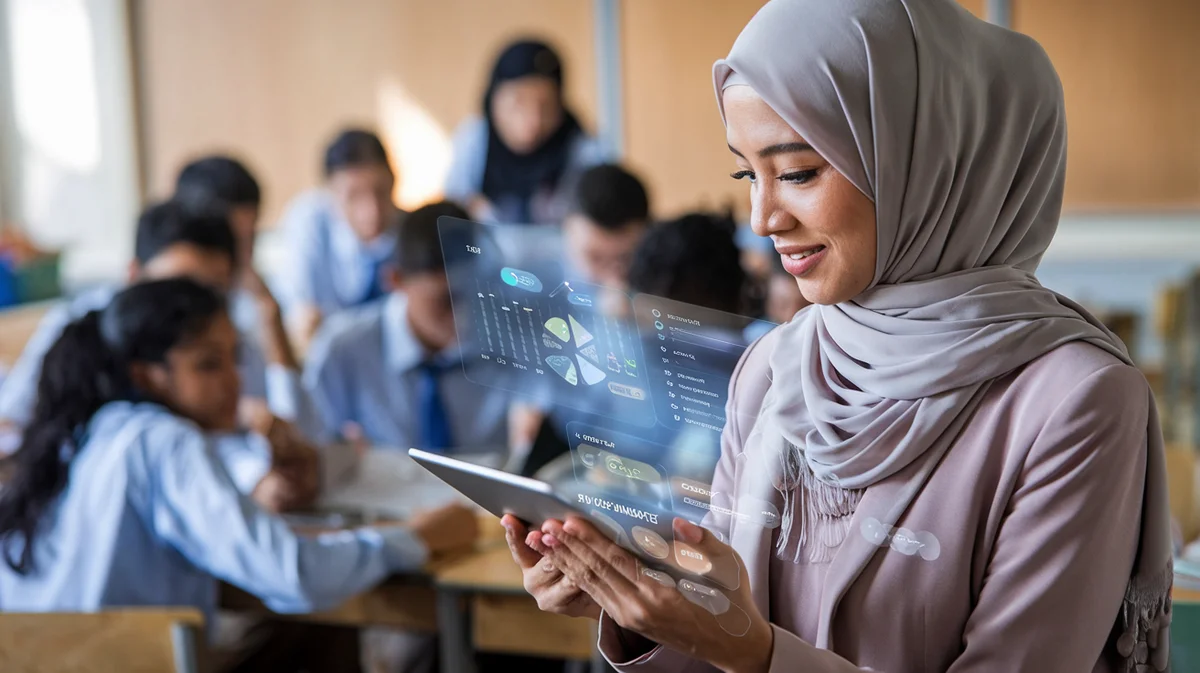Technology in Inclusive Education Tools


wp:paragraph
Inclusive education is no longer a distant ideal — it is a global imperative, recognized by governments, institutions, and international organizations alike. At UNOWA, we are proud to be at the forefront of this transformation, designing and delivering complete educational systems that empower all learners. In this article, we explore how technology is revolutionizing inclusive education, the challenges and opportunities it presents, and proven strategies for large-scale, sustainable impact across the EU, MENA, and CIS regions.
/wp:paragraph
wp:heading {"level":2}
The Imperative for Inclusive Education
/wp:heading
wp:paragraph
Inclusive education ensures that every learner, regardless of ability, background, or circumstance, has equitable access to quality education. This principle is enshrined in the United Nations’ Sustainable Development Goal 4, which calls for inclusive and equitable education and lifelong learning opportunities for all (UN SDG 4). Across Europe, the Middle East, and Central Asia, there is a clear policy shift away from segregated models and towards systems that embrace diversity and digital transformation.
/wp:paragraph
wp:heading {"level":3}
Key Facts and Statistics
/wp:heading
wp:list
- In Central and Eastern Europe, the Caucasus, and Central Asia, out-of-school rates have halved over the past 20 years.
- The percentage of children with disabilities in special schools dropped from 78% in 2005/06 to 53% in 2015/16.
- 23 out of 30 education systems reviewed offer counselling and mentoring; 22 provide learning assistance; 21 have specialist and therapist support.
- Despite progress, only a minority of countries have fully supportive legislation matched with adequate resources (European Agency Statistics on Inclusive Education).
/wp:list
wp:heading {"level":2}
How Technology Empowers Inclusive Education
/wp:heading
wp:heading {"level":3}
Inclusive Education Tools: The Game Changers
/wp:heading
wp:paragraph
At UNOWA, we believe that inclusive education tools are the cornerstone of modern, equitable learning environments. These tools are not just add-ons — they are integral to the design of our systems, from MIKKO (our inclusive education suite) to Ulabs (our STEM innovation platform).
/wp:paragraph
wp:heading {"level":4}
Assistive Technologies
/wp:heading
wp:list
- Screen readers, speech-to-text software, and alternative input devices are now standard in many classrooms, enabling students with visual, auditory, or motor challenges to participate fully.
- These tools are especially impactful in remote or underserved areas, where specialist support may be limited.
/wp:list
wp:heading {"level":4}
Universal Design for Learning (UDL)
/wp:heading
wp:list
- Digital platforms are increasingly built on UDL principles, ensuring content is accessible to all from the outset.
- This approach benefits not only students with special educational needs (SEN) but also those with different learning styles or language backgrounds.
/wp:list
wp:heading {"level":4}
Online Learning Platforms
/wp:heading
wp:list
- Personalized learning paths, adaptive assessments, and resources in multiple formats (text, audio, video) support a wide range of learners.
- Real-time analytics enable educators to identify students needing additional support and tailor interventions accordingly.
/wp:list
wp:heading {"level":4}
Teacher Training and Professional Development
/wp:heading
wp:list
- Effective use of inclusive education tools requires ongoing investment in teacher training.
- At UNOWA, we provide comprehensive professional development in digital pedagogy and inclusive practices, ensuring educators are confident and empowered to use technology for inclusion.
/wp:list
wp:heading {"level":3}
Large-Scale Impact: From Pilot to Policy
/wp:heading
wp:paragraph
One of the most profound advantages of digital transformation is scalability. Inclusive education tools allow for rapid deployment of best practices across entire regions, bridging gaps between urban and rural schools and ensuring no learner is left behind.
/wp:paragraph
wp:list
- Data-driven decision making: Technology enables ministries and institutions to monitor student progress in real time, allocate resources efficiently, and measure the impact of interventions.
- Cross-sector collaboration: Digital platforms facilitate collaboration between education, health, and social sectors, creating holistic support systems for learners.
/wp:list
wp:heading {"level":2}
Policy, Regulation, and Government Guidelines
/wp:heading
wp:heading {"level":3}
EU
/wp:heading
wp:paragraph
The European Commission and member states have made inclusive education a policy priority, aligning with SDG 4. Annual data collection and policy reviews inform ongoing reforms, with a focus on both legal rights and practical implementation (European Commission: Inclusive Education).
/wp:paragraph
wp:heading {"level":3}
MENA and CIS
/wp:heading
wp:paragraph
Many countries in these regions have adopted rights-based approaches to inclusion. However, implementation varies, and in some cases, school admission for students with special needs still depends on medical-psychological assessments. Legal frameworks are evolving, but there is a recognized gap between policy and the allocation of resources necessary for full inclusion (UNESCO GEM Report).
/wp:paragraph
wp:heading {"level":2}
Challenges and Opportunities
/wp:heading
wp:heading {"level":3}
Awareness and Attitudes
/wp:heading
wp:paragraph
While awareness of the rights and potential of learners with SEN is growing, societal attitudes and practical barriers remain. Changing mindsets is as important as changing systems.
/wp:paragraph
wp:heading {"level":3}
Resource Gaps
/wp:heading
wp:paragraph
Even where inclusive policies exist, lack of funding and trained personnel can limit their effectiveness. Bridging this gap requires sustained investment and international cooperation.
/wp:paragraph
wp:heading {"level":3}
The Role of Data
/wp:heading
wp:paragraph
Robust data collection is essential for tracking progress and identifying areas for improvement. The European Agency Statistics on Inclusive Education (EASIE) provides valuable insights into the number of children in inclusive settings and the effectiveness of various approaches.
/wp:paragraph
wp:heading {"level":2}
Proven Strategies for Success
/wp:heading
wp:paragraph
Drawing on our experience with over 300 national projects, we recommend the following strategies for ministries, curriculum authorities, and educational institutions:
/wp:paragraph
wp:list
- Invest in both technology and teacher training: Tools are only as effective as the people using them.
- Ensure legal rights are matched by funding and resources: Policy must be backed by practical support.
- Foster collaboration between education, health, and social sectors: Inclusion is a shared responsibility.
- Use data to inform targeted interventions and monitor progress: Evidence-based decision making is key to sustainable impact.
/wp:list
wp:heading {"level":2}
Recent Developments
/wp:heading
wp:paragraph
The COVID-19 pandemic accelerated investment in digital infrastructure and inclusive edtech solutions. Countries are updating their definitions and practices of inclusion, with a trend towards broader, more flexible support systems in schools. There is a growing recognition that inclusive education tools are essential for resilience and equity in education systems.
/wp:paragraph
wp:heading {"level":2}
UNOWA’s Commitment
/wp:heading
wp:paragraph
With over 15 years of experience, we at UNOWA are dedicated to transforming learning experiences for the better. Our solutions are adaptable to national standards and ready for large-scale impact, empowering institutions, educators, and students across the EU, MENA, and CIS regions. We believe every child deserves access to quality education, regardless of their abilities.
/wp:paragraph
wp:paragraph
Learn more about our approach and solutions at UNOWA.
/wp:paragraph
wp:heading {"level":2}
Useful Resources
/wp:heading
wp:list
- UN SDG 4: Quality Education
- European Agency for Special Needs and Inclusive Education
- UNESCO Global Education Monitoring Report
- European Commission: Inclusive Education
- UNOWA
/wp:list
wp:heading {"level":2}
FAQ: Technology in Inclusive Education
/wp:heading
wp:paragraph
What are inclusive education tools? Inclusive education tools are technologies and resources designed to ensure all students, including those with special educational needs, can access and benefit from quality education. Examples include assistive technologies, adaptive learning platforms, and digital content aligned with universal design principles.
/wp:paragraph
wp:paragraph
How does technology support inclusive education? Technology enables personalized learning, real-time assessment, and access to diverse resources. It also helps educators identify and support students who need additional help, making education more equitable and effective.
/wp:paragraph
wp:paragraph
What challenges remain in implementing inclusive education? Key challenges include insufficient funding, lack of trained personnel, and societal attitudes. Bridging the gap between policy and practice requires sustained investment and collaboration.
/wp:paragraph
wp:paragraph
How can ministries and institutions scale inclusive education? By investing in digital infrastructure, teacher training, and robust data systems, ministries and institutions can scale inclusive practices and monitor their impact effectively.
/wp:paragraph
wp:paragraph
Where can I learn more about UNOWA’s solutions? Visit UNOWA to explore our complete educational systems, inclusive education tools, and professional development offerings.
/wp:paragraph
wp:paragraph
Empowering educators to create a brighter future for all students is at the heart of what we do. Let’s work together to transform learning experiences for the better.
/wp:paragraph








